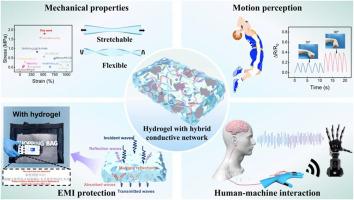柔性导电水凝胶通过优化混合填料的界面连通性向高效电磁干扰屏蔽和可穿戴应变传感器方向发展
IF 7.7
2区 材料科学
Q1 MATERIALS SCIENCE, COMPOSITES
引用次数: 0
摘要
导电性水凝胶在可穿戴柔性传感器和电磁干扰(EMI)屏蔽材料中具有巨大的潜力,因为它们具有仿组织的机械顺应性和富水的多孔结构。然而,同时实现高电磁干扰屏蔽效率(SE)和优异的机械性能仍然是一个挑战。为了解决这个问题,我们在水凝胶体系中提出了一种混合导电网络策略,通过将碳纳米管和镍包覆石墨结合到水凝胶基质中。由于凝胶网络内的多维填充网络、丰富的氢键和静电相互作用的协同结合,所得到的复合水凝胶具有显著的拉伸性、可靠性和抗疲劳能力。更重要的是,得益于中等导电性和凝胶内部富水环境的协同作用,厚度为2mm的复合水凝胶在x波段表现出58 dB的特殊EMI SE,优于迄今为止报道的大多数EMI屏蔽水凝胶。此外,将水凝胶传感器与机器学习相结合,实现了精确稳定的手势识别和远程控制,精度高达100%。这项工作为推进柔性水凝胶传感器技术提供了一个新的视角,并强调了它们在智能可穿戴设备、卓越的电磁干扰屏蔽材料和人机交互方面的巨大潜力。本文章由计算机程序翻译,如有差异,请以英文原文为准。

Flexible conductive hydrogels through optimized interfacial connectivity of hybrid fillers toward efficient electromagnetic interference shielding and wearable strain sensors
Conductive hydrogels hold significant potential in wearable flexible sensors and electromagnetic interference (EMI) shielding materials owing to their tissue-mimetic mechanical compliance and water-rich porous structures. However, simultaneously achieving high EMI shielding efficiency (SE) and excellent mechanical properties remain a challenge. To address this issue, we present a hybrid conductive network strategy within the hydrogel system through incorporating carbon nanotubes and nickel-coated graphite into a hydrogel matrix. The resulting composite hydrogel demonstrates remarkable stretchability, reliability, and anti-fatigue capability, owing to the synergistic combination of the multi-dimensional filler network, abundant hydrogen bonds and electrostatic interactions within the gel network. More importantly, profiting from the synergy of moderate conductivity and internal water-rich environment of the gel, the composite hydrogel at a thickness of 2 mm exhibits an exceptional EMI SE of 58 dB in the X-band, which is superior to most of the EMI shielding hydrogels reported to date. In addition, integrating the hydrogel sensor with machine learning, precise and stable gesture recognition and remote control are realized with an accuracy of up to 100%. This work offers a novel perspective for advancing flexible hydrogel sensor technologies and underscores their vast potential in intelligent wearable devices, superb EMI shielding materials, and human-machine interactions.
求助全文
通过发布文献求助,成功后即可免费获取论文全文。
去求助
来源期刊

Composites Communications
Materials Science-Ceramics and Composites
CiteScore
12.10
自引率
10.00%
发文量
340
审稿时长
36 days
期刊介绍:
Composites Communications (Compos. Commun.) is a peer-reviewed journal publishing short communications and letters on the latest advances in composites science and technology. With a rapid review and publication process, its goal is to disseminate new knowledge promptly within the composites community. The journal welcomes manuscripts presenting creative concepts and new findings in design, state-of-the-art approaches in processing, synthesis, characterization, and mechanics modeling. In addition to traditional fiber-/particulate-reinforced engineering composites, it encourages submissions on composites with exceptional physical, mechanical, and fracture properties, as well as those with unique functions and significant application potential. This includes biomimetic and bio-inspired composites for biomedical applications, functional nano-composites for thermal management and energy applications, and composites designed for extreme service environments.
 求助内容:
求助内容: 应助结果提醒方式:
应助结果提醒方式:


